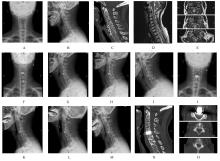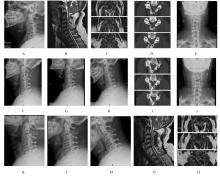| 2 |
顾一飞, 曹 鹏, 陈华江, 等. 老年多节段脊髓型颈椎病矢状面平衡特点及手术入路比较[J]. 脊柱外科杂志, 2020, 18(4): 253-257.
|
| 3 |
袁 一, 李翔宇, 刘承鑫, 等. 不同术式对多节段脊髓型颈椎病患者颈椎矢状位形态的矫形效果[J]. 脊柱外科杂志, 2022, 20(5): 302-306, 312.
|
| 4 |
王 锋, 龙耀武, 赵 睿, 等. 两种手术方式治疗脊髓型颈椎病的疗效比较[J]. 临床骨科杂志, 2021,24(4): 457-460.
|
| 5 |
马旭东, 高 海, 孔 雷, 等. 颈后路单开门椎管扩大成形术和全椎板切除减压术治疗脊髓型颈椎病的中短期疗效分析[J].颈腰痛杂志,2022,43(6):835-837.
|
| 6 |
马伽成, 武东文, 方储存, 等. 颈椎后路单、双开门椎管扩大成形术治疗多节段脊髓型颈椎病的早期临床疗效比较[J]. 吉林医学, 2022, 43(10): 2638-2640.
|
| 7 |
高雪伟, 邓 昶, 李 涛, 等. 不同手术方式治疗多节段脊髓型颈椎病的手术效果及影响因素分析[J]. 中国综合临床, 2022, 38(4): 344-350.
|
| 8 |
纪小孟, 刘 璠, 王 健, 等. 颈椎前路减压双嵌片自稳型颈椎融合器治疗脊髓型颈椎病[J]. 临床骨科杂志, 2020, 23(4): 457-460.
|
| 9 |
耿 寅, 刘 晨, 肖 良, 等. Zero-p融合器置入与钛板内固定治疗单节段脊髓型颈椎病临床疗效比较[J]. 沈阳医学院学报, 2023, 25(1): 5-9.
|
| 10 |
刘 浩, 周显平, 陈国军, 等. 对零切迹椎间融合器治疗单节段颈椎病的临床疗效观察[J]. 骨科临床与研究杂志, 2023, 8(1): 39-43.
|
| 11 |
来佳辉, 罗建平, 张新胜, 等. ACDF治疗单节段脊髓型颈椎病合并发育性颈椎管狭窄临床疗效分析[J]. 中国脊柱脊髓杂志, 2021, 31(7): 605-612.
|
| 12 |
雷润博, 李 盼, 甘 璐, 等. 单节段Discover人工颈椎间盘置换术与颈前路减压融合术治疗颈椎病的长期疗效对比[J]. 中国脊柱脊髓杂志, 2022, 32(8): 688-695.
|
| 13 |
袁 文. 对多节段脊髓型颈椎病手术方案选择的要素[J]. 中国脊柱脊髓杂志, 2009, 19(7): 483-484.
|
| 14 |
朱 超, 刘 春, 张玉发, 等. 零切迹融合器在颈前路椎间盘切除融合术治疗多节段脊髓型颈椎病中的应用价值[J]. 中国脊柱脊髓杂志, 2022, 32(4): 347-355.
|
| 15 |
叶福标, 尹晓明, 林飞跃, 等. 多节段脊髓型颈椎病两种减压融合术的比较[J]. 中国矫形外科杂志, 2022, 30(7): 608-613.
|
| 16 |
杨子明, 李 放, 陈华江. 颈椎病的分型、诊断及非手术治疗专家共识(2018)[J]. 中华外科杂志,2018, 56(6): 401-402.
|
| 17 |
LIU T, XU W, CHENG T, et al. Anterior versus posterior surgery for multilevel cervical myelopathy, which one is better? A systematic review[J]. Eur Spine J, 2011, 20(2): 224-235.
|
| 18 |
KONG C, LI X Y, SUN X Y, et al. The ratio of C2-C7 Cobb angle to T1 slope is an effective parameter for the selection of posterior surgical approach for patients with multisegmental cervical spondylotic myelopathy[J]. J Orthop Sci, 2020, 25(6): 953-959.
|
| 19 |
HIRAI T, OKAWA A, ARAI Y, et al. Middle-term results of a prospective comparative study of anterior decompression with fusion and posterior decompression with laminoplasty for the treatment of cervical spondylotic myelopathy[J]. Spine, 2011, 36(23): 1940-1947.
|
| 20 |
HIRAI T, YOSHII T, INOSE H, et al. Is modified K-line a powerful tool of surgical decision making for patients with cervical spondylotic myelopathy?[J]. Clin Spine Surg, 2019, 32(9): 351-356.
|
| 21 |
MAO N F, WU J H, ZHANG Y, et al. A comparison of anterior cervical corpectomy and fusion combined with artificial disc replacement and cage fusion in patients with multilevel cervical spondylotic myelopathy[J]. Spine, 2015, 40(16): 1277-1283.
|
| 22 |
HILIBRAND A S, FYE M A, EMERY S E, et al. Increased rate of arthrodesis with strut grafting after multilevel anterior cervical decompression[J]. Spine, 2002, 27(2): 146-151.
|
| 23 |
PARK D H, RAMAKRISHNAN P, CHO T H, et al. Effect of lower two-level anterior cervical fusion on the superior adjacent level[J].J Neurosurg Spine,2007,7(3): 336-340.
|
| 24 |
齐英娜, 李春根, 柳根哲, 等. 颈椎前路Hybrid术治疗颈椎退行性疾病[J]. 中国骨伤, 2021, 34(1): 80-85.
|
| 25 |
SAKAI K, YOSHII T, HIRAI T, et al. Impact of the surgical treatment for degenerative cervical myelopathy on the preoperative cervical sagittal balance: a review of prospective comparative cohort between anterior decompression with fusion and laminoplasty[J]. Eur Spine J, 2017, 26(1): 104-112.
|
| 26 |
秦志勇, 黄 懿, 马 迅, 等. 颈后路术后轴性症状相关研究进展[J]. 颈腰痛杂志, 2022, 43(4): 607-609.
|
| 27 |
SENG C S, TOW B P B, SIDDIQUI M A, et al. Surgically treated cervical myelopathy: a functional outcome comparison study between multilevel anterior cervical decompression fusion with instrumentation and posterior laminoplasty[J].Spine J,2013,13(7): 723-731.
|
| 28 |
陈浩波, 陈 源, 陈方兴, 等. 颈椎前后路联合手术治疗颈椎管狭窄联合颈髓损伤的临床疗效[J]. 吉林医学, 2020, 41(7): 1690-1691.
|
| 29 |
于 雷, 袁绍辉. 多节段脊髓型颈椎病手术策略的研究进展[J]. 医学综述, 2018, 24(1): 117-121.
|
 ),Genzhe LIU2,Ziyi ZHAO2,Sihao ZHAO2,Chao CHEN2,Yonggang ZHU2,Wei LI1,2
),Genzhe LIU2,Ziyi ZHAO2,Sihao ZHAO2,Chao CHEN2,Yonggang ZHU2,Wei LI1,2







